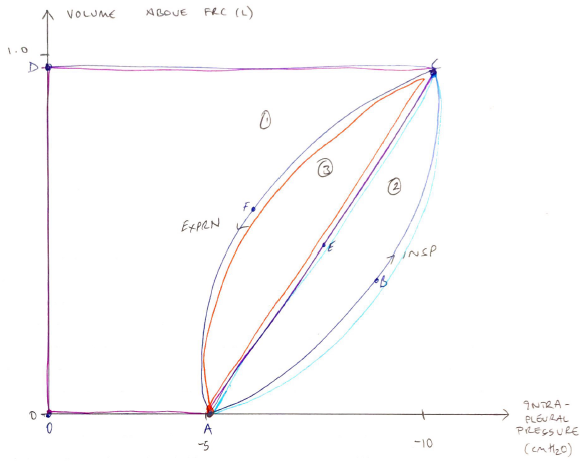F3xi / 21A02: Describe the work of breathing and its components
21A02: Exam Report
Describe the work of breathing and its components.
24% of candidates passed this question.
This is a core topic within respiratory physiology. There was a very low pass rate for this question. Expected components of the answer included: a definition of WOB as a product of pressure and volume or force and distance including the units of measurement; followed by a detailed explanation of the following three broad components – elastic resistance, viscous resistance and airflow resistance. Further marks were awarded to situations where the energy for expiration increases beyond stored potential energy as well as the impact of respiratory rate and tidal volume on different aspects of the WOB. For example, the changes in TV will have relatively greater impact on the elastic component, whereas RR will impact the resistance component. Additional marks were awarded for describing the efficiency of breathing. A common area where candidates missed out on marks was producing a diagram of WOB without a description; many diagrams were often incorrectly drawn or had no axes labelled. There were many incorrect definitions or respiratory equations provided without any link to the written answer. Factual inaccuracy and limited depth of knowledge were also prevalent in poorly performing answers. Marks were not awarded for a description of the control of breathing.
F3xi / 21A02: Describe the work of breathing and its components
Units of Work
- Work = force (Newtons) x distance (metres)
- SI unit is Joules
Work of Breathing
- Work = force x distance
= PRESSURE x VOLUME
- WoB = the energy expended by lungs & chest wall in order for ventilation to take place
= O2 consumed for ventilation to take place ~3mL/min (5% O2 consumption)
2 Types of WOB
1. Resistance Work
- To overcome airway & tissue R
- E used is dissipated as heat
- 50% of WoB (INSP + EXPR)
2. Elastance Work
- To overcome elastic recoil of lung & CW
- E used is stored as potential E in the deformed elastic tissue (of lung & CW)
- Then is used to overcome resistance forces during EXPR → rest dissipated as heat
- 50% WoB
PV Curve of WOB
- WoB displayed on PV curve

Inspiration
- 0AECD0 = work to overcome elastic forces
- ABCEA = work to overcome resistance forces
- For gas flow you need a gradient b/w mouth P & alv P
- Intrapleural P AEC is not enough
- R) bulge ABC shows how much -ve
- Intrapleural P is required to overcome resistance forces
- ↑RAW would bulge R) even further & generate more work
Expiration
- AECFA = work to overcome resistance forces
- Because this falls within 0AECD0, it is overcome with stored E from INSP
0AECD0 – AECFA = work dissipated as heat
Total Work Done = OABCDO
- E stored in elastic tissue during INSP
- Work of resistance INSP
- Work of resistance EXPR
At (rest) tidal breathing (1) > (3) & stored E can be used for passive exhalation
↑RAW/↑RR = ↑(2) & ↑(3)
- Stored elastic E might be insufficient if (3) > (1)
Minimising WOB
- Optimise RR
- Breath from FRC
- Passive expiration
- Minimise RAW
- Try & ensure laminar flow (Re < 2000)
Author: Krisoula Zahariou